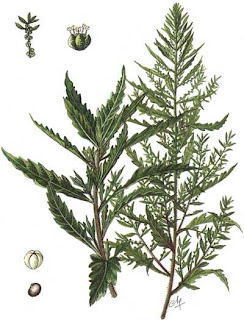
English names:
American wormseed, Mexican tea, wormseed goosefoot, Jerusalem tea, Mexican goosefoot, American goosefoot.
Description:
Annual or perennial herb, 0.5-1 m. high. Stems and twigs striate, glandular-pubescent, green or purple. Leaves alternate, sinuate-dentate, glandular-pubescent beneath. Flowers minute, in simple or paniculate axillary leafy spike. Utricle globular, membranous, pale-green. Seeds black, shining. All parts of the herb have a disagreeable strong smell.
Flowering period:
May - July.
Distribution:
Grows wild on river-banks.
Parts used:
The whole plant, except for the roots, can be harvested all the year round, but preferably in May and June. After cutting, the plants must be immediately distilled to obtain the chenopodium essential oil.
Chemical composition:
The whole plant contains essential oil (leaves 0.3-0.5%, seeds 1%) consisting of ascaridol, p-cymene, limonene, pinocarvone, aritason.
Therapeutic uses:
The essential oil of the entire plant is an anthelminthic for Ascaris and Oxyuris. The dose for adults is 1 ml of chenopodium essential oil diluted in 30 ml of castor oil or in capsules. The purgative magnesium sulfate is administered later. It is indicated for children over five years of age. The dose, depending on their age, is 10 to 20 drops of chenopodium essential oil. It is highly toxic, so strict precautions are necessary.
Source: Medicinal plants in Viet Nam (Institute of Materia Medica).
American wormseed, Mexican tea, wormseed goosefoot, Jerusalem tea, Mexican goosefoot, American goosefoot.
Description:
Annual or perennial herb, 0.5-1 m. high. Stems and twigs striate, glandular-pubescent, green or purple. Leaves alternate, sinuate-dentate, glandular-pubescent beneath. Flowers minute, in simple or paniculate axillary leafy spike. Utricle globular, membranous, pale-green. Seeds black, shining. All parts of the herb have a disagreeable strong smell.
Flowering period:
May - July.
Distribution:
Grows wild on river-banks.
Parts used:
The whole plant, except for the roots, can be harvested all the year round, but preferably in May and June. After cutting, the plants must be immediately distilled to obtain the chenopodium essential oil.
Chemical composition:
The whole plant contains essential oil (leaves 0.3-0.5%, seeds 1%) consisting of ascaridol, p-cymene, limonene, pinocarvone, aritason.
Therapeutic uses:
The essential oil of the entire plant is an anthelminthic for Ascaris and Oxyuris. The dose for adults is 1 ml of chenopodium essential oil diluted in 30 ml of castor oil or in capsules. The purgative magnesium sulfate is administered later. It is indicated for children over five years of age. The dose, depending on their age, is 10 to 20 drops of chenopodium essential oil. It is highly toxic, so strict precautions are necessary.
Source: Medicinal plants in Viet Nam (Institute of Materia Medica).

When my daughter was born, the last thing I remember the anesthesiologist saying to me is "You could be having the next president of the United States!" and my reply to her was "Oh God, I hope not!"
ReplyDelete(I was given magnesium sulfate -- kind of like being under the influence of many cocktails -- and because of other issues, had to be under general anesthesia. We also didn't know if the baby was a boy or girl, not that it really mattered.)